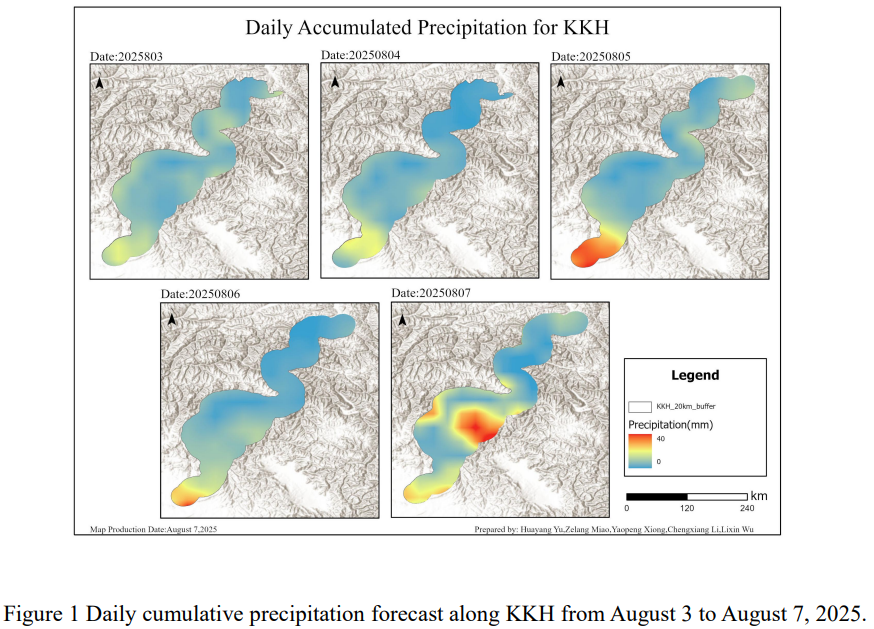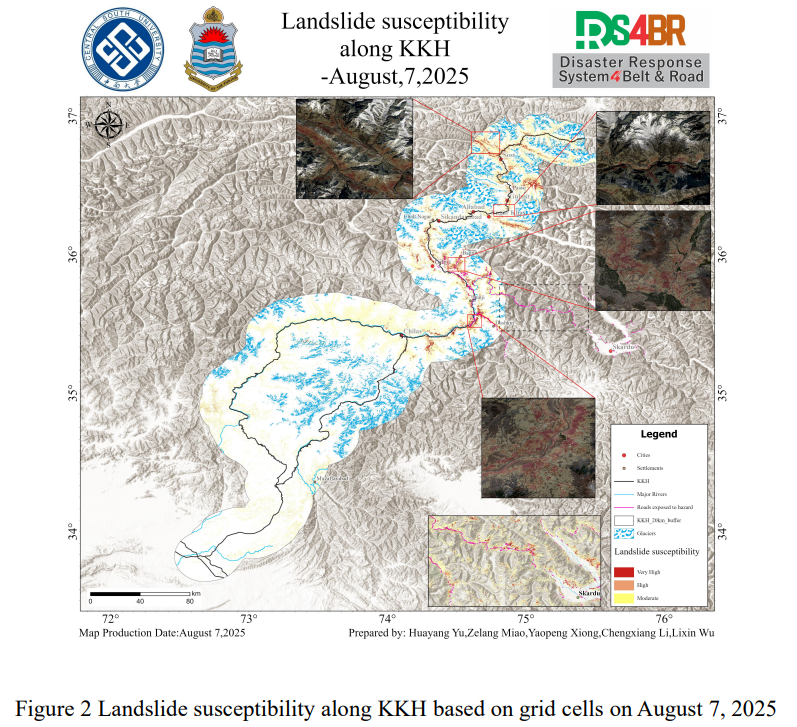

Combined with the precipitation forecast based on the NCFP GFS model on August 7, 2025 and multi-source data such as lithology, DEM and hydrological conditions along the Karakoram Highway, the TRIGRS model was adopted to conduct the landslide risk assessment in the northern area that was greatly affected by rainfall. The NCEP GFS precipitation forecast shows that on August 7th, the overall rainfall along the Karakoram Highway will increase, with the highest value reaching 37mm. The precipitation will mainly be concentrated in the southern region, while the northern mountainous areas will receive less rainfall. Although the total amount of rainfall in the northern region is limited, due to the accumulation of previous precipitation and continuous infiltration, the pore water pressure of some slopes has increased. The TRIGRS model shows that its stability is approaching a critical state, and the susceptibility to landslides still cannot be ignored.
The assessment results show (Figure 2) that the extremely high and highly prone areas are mainly distributed in a band-like pattern along the main river valley corridors in the north, concentrated in mountainous areas with significant terrain undulations and deep rivers, especially in the sections around Chilas and Gilgit and north of Gulmit. These areas generally have steep slopes and high-density steep slopes, and the foot of the slope is close to major rivers and transportation arteries. Locally, they form clusters of high-risk values for landslides, constituting the core area of the landslide risk pattern in the northern region. In contrast, the total amount of rainfall in the southern region is relatively high. The overall susceptibility to landslides remains mainly at a medium level, with scattered spatial distribution and a patchy pattern. This difference may be related to the extensive glacier coverage in the area south of Chilas. The lagging response of glaciers to rainfall runoff and their impact on surface stability may, to a certain extent, suppress the rapid and concentrated manifestation of landslide risks. Moreover, the terrain in the southern region is relatively flat. Overall, although the total amount of rainfall in the southern region was greater, the spatial range of extremely high and highly susceptible areas did not show a significant expansion. In the northern region, despite relatively low rainfall, the distribution of high-risk areas for landslides remains relatively stable, controlled by complex terrain and dense river valley networks, and the coverage area has not undergone significant changes.
Afurther susceptibility analysis was conducted on the GilGit-Skardu route. Due to the large area of the high-susceptibility zone on the section from Gilgit to Skardu, the affected highway section is also relatively long, with a total length of 143.40 kilometers. Near Skardu, due to the steep terrain and concentrated rainfall, the risk of landslides has significantly increased, and enhanced monitoring and preventive measures are needed.
From the results of susceptibility, it can be seen that the sections along the KKH such as the Chilas-Gilgit section and the section north of Gulmit, which are highly prone to occurrence, should be regarded as key risk areas. Special attention should be paid to disasters such as high and steep cutting slopes and mudslides during and after rainfall..
结合 2025 年 8月 7日基于 NCFPGFS 模式的降水预报与喀喇昆仑公路沿线的岩性、DEM、水文条件等多源数据,采用TRIGRS模型,对受降雨影响较大的北部地区展开滑坡 危险性评估。NCEPGFS降水预报显示,8 月 7 日,喀喇昆仑公路沿线整体降雨量有所升高,最高值为37mm,降水主要集中在南部地区,北部山区降雨较少。尽管北部地区降雨总 量有限,但受前期降水累积及持续入渗作用影响,部分坡体孔隙水压力升高,TRIGRS 模型显示其稳定性已接近临界状态,滑坡易发性依然不容忽视。
评估结果表明(图2),极高及高易发区主要沿北部主要河谷走廊呈带状分布,集中出现在地形起伏显著、河流深切的山地地带,尤以 Chilas、Gilgit 周边及 Gulmit 以北路段最为典型。这些区域普遍存在陡峭坡面、高密度陡坡,且坡脚邻近主要河流与交通干线,局部 形成滑坡高风险值的聚集区,构成了北部地区滑坡风险格局的核心区域。相较之下,南部区域降雨总量较多,整体滑坡易发性仍以中等等级为主,空间分布零散,呈现斑块状格局。此差异可能与 Chilas 以南地区广泛分布的冰川覆盖有关,冰川对降雨径流的滞后响应及其对 地表稳定性的影响可能在一定程度上抑制了滑坡风险的快速集中表现。且南部地区地形较为平坦。总体而言,尽管南部区域降雨总量更大,但极高及高易发区的空间范围未出现明显扩展;而北部地区在降雨量相对较小的情况下,受控于复杂地形与密集河谷网络,滑坡高易发 区分布仍保持相对稳定,覆盖范围亦未发生明显变化。
对Gilgit-Skardu 线路进行进一步的易发性分析,由于从Gilgit到Skardu地区路段的高易发性区域面积较大,因此受影响的公路路段线路也比较长,总长为143.40km。在Skardu附近,受地形陡峭和降雨集中影响,滑坡风险显著增加,需加强监测与防范措施。
从易发性结果可以看出,沿 KKH 穿越的Chilas-Gilgit路段 、Gulmit以北段等高易发性路段应被视为重点风险区段,需重点关注在降雨过程中与雨后的高陡切坡、泥石流等灾害。